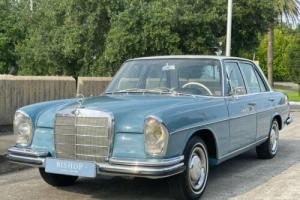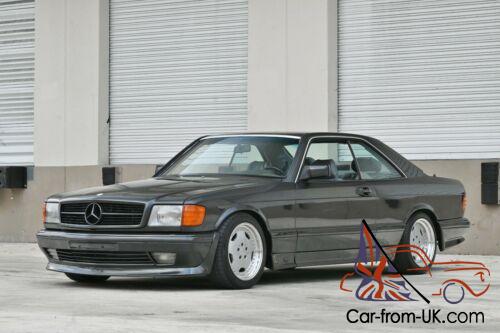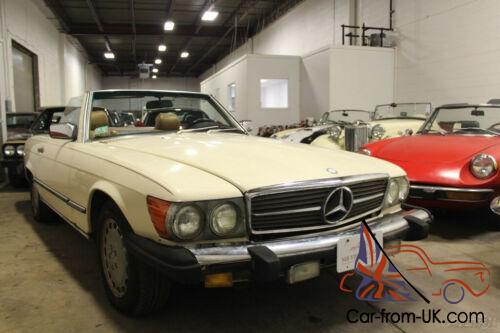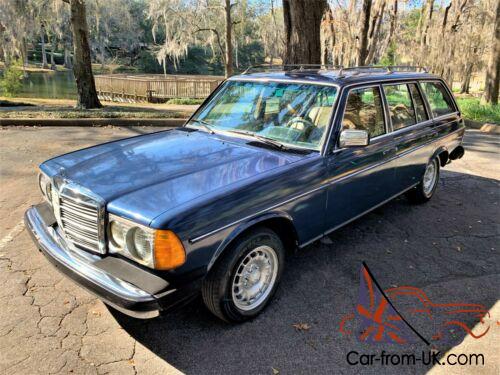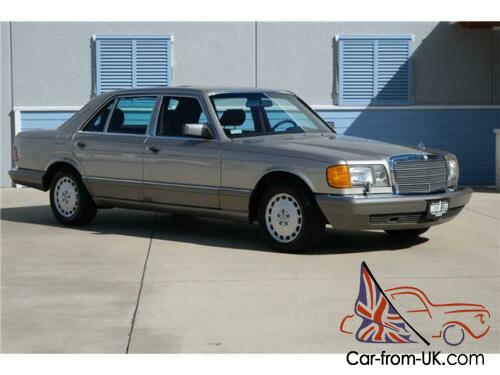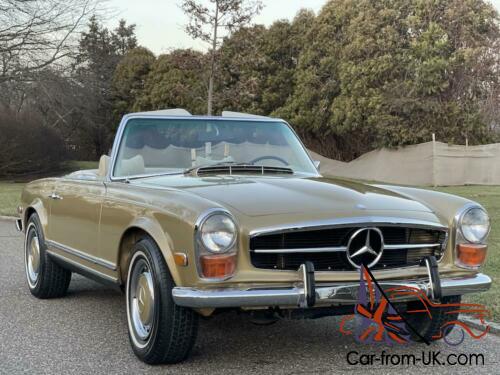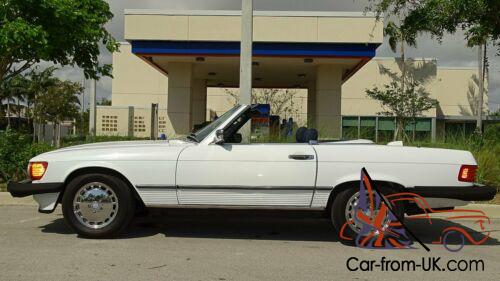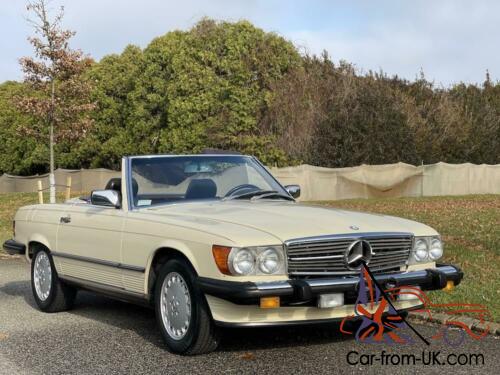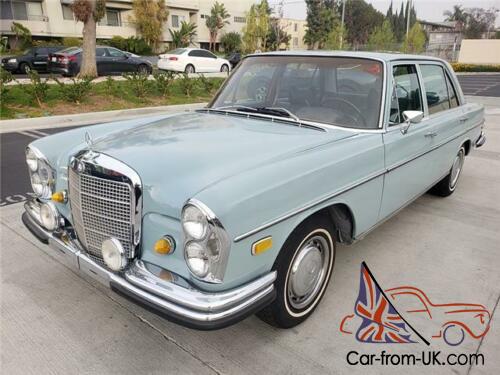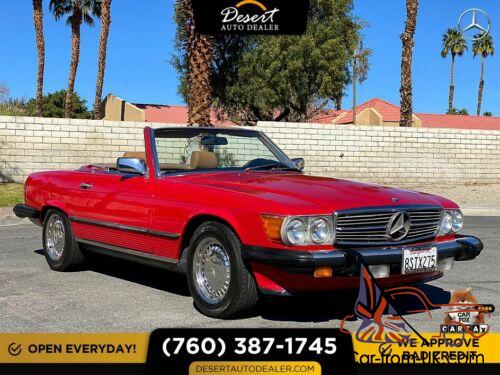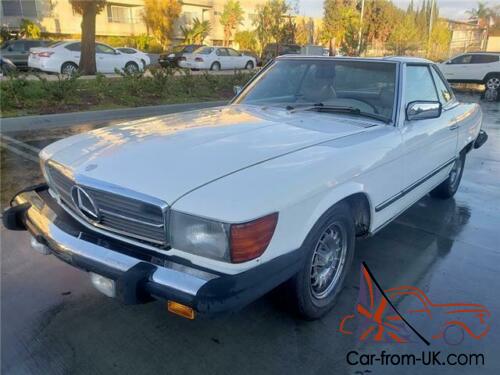Classic Cars / Mercedes-Benz / Car for sale
1966 Mercedes-Benz 200-Series Light-Blue/White-Grey / Parchment
Sale price: $35,000.00 Make an offer
Car location: Jacksonville, Florida, United States
Sale type: Fixed price listing
Technical specifications, photos and description:
- Make:
- Mercedes-Benz
- Year:
- 1966
- Got questions?
- Ask here!
1966 Mercedes-Benz 200-Series Light-Blue/White-Grey / Parchment for sale
Current customer rating:
General:
The Mercedes-Benz W 108 Series premiered at the
Frankfurt Auto Show
in 1965. The initialmodel range consisted of three W 108 s (250 S, 250 SE, and 300 SEb). Theinline-six engines were carried over from the previous generation withmechanical refinements. The 2.2-litre
M 180
engine was enlarged to 2.5 litres while the fuel-injected 3-litre
M 189
version was carried over from"300 Adenauer".
The 250 S was fitted with 2,496 cc
M 108 engine
with dual two-barreldowndraft
carburettors
producing 96 k W (131 PS 129 bhp) at 5,400 rpm. It could accelerate to 100 km/h (62 mph)in 13 seconds for manual and 14 for automatic. The top speed was 182 km/h(113 mph) for manual and 177 km/h (110 mph) for automatic. The 250 SE had the same engine as 250 S except for fuel injection system anddifferent engine designation
(M 129) . With increased engine output of 110 k W (150 PS 148 bhp) at 5,500 rpm, 250 SE was one secondfaster to 100 km/h than 250 S and had higher top speed of 193 km/h(120 mph) for both manual and automatic versions.
The “bugs” that plague many new cars were snuffed out long agoin the 250. It was 5 years being readied – on the test track, on the Autobahnsand Italy's Autostradas, in Africa's heat and Scandinavia's cold.
Within reasonable cost at the time, it embodied every technicaladvance known to the engineers of Mercedes-Benz, allied with the comfort of thenew body design. And none of the W 108 Sedans are status symbols. All are full 5-passenger automobiles, perhaps the most technically sophisticated passengercars in existence at the time. At the time you could load this one and ahalf-ton machine with friends and baggage – and rip around a road-racing coursequicker than many exotic sports cars. And safer, before all.
The 250 S abolished the curse of rough-road riding, the solidrear axle. Each wheel on the 250 S is separately sprung. Harshness of the roadsurface is damped by the rubber “biscuits” that scotch metal-to-metal jarringbetween suspension and chassis. Its brawny coil springs, wide-stanced shockabsorbers and a front anti-roll torsion bar fend off any hint of wallow, lurchor sway. A pleasant detail: the steering linkage carries its own shockabsorber. Tremors and jolts never reach driver's hands on the wheel.
The skittish braking – is forgotten on the 250 S. Larger 14-inchwheels were introduced to fit the 250's caliper-type, 10-inch disc brakes.Discs are used on each wheel – and are standard equipment. A sensitiveservo-booster, not driver's leg muscles, supplies braking effort.
A brake control automatically balances frontand rear braking forces – no rear wheel lock-up in emergencies.
Vibration of the engine is smothered by anelectronically-balanced 7-main-bearing crankshaft. A viscose drive cooling fanautomatically cuts out when not needed, saving power while muffling noise atcruising speeds.
The 250 S “sips” fuel: 20-25 miles per gallon.
The production figures for the first series from 1965 to 1967 showed 129,858 of 250 S/250 SE. *About this car:1966 Mercedes-Benz 250 S (W 108)VIN # 108
The Mercedes-Benz W 108 Series premiered at the
Frankfurt Auto Show
in 1965. The initialmodel range consisted of three W 108 s (250 S, 250 SE, and 300 SEb). Theinline-six engines were carried over from the previous generation withmechanical refinements. The 2.2-litre
M 180
engine was enlarged to 2.5 litres while the fuel-injected 3-litre
M 189
version was carried over from"300 Adenauer".
The 250 S was fitted with 2,496 cc
M 108 engine
with dual two-barreldowndraft
carburettors
producing 96 k W (131 PS 129 bhp) at 5,400 rpm. It could accelerate to 100 km/h (62 mph)in 13 seconds for manual and 14 for automatic. The top speed was 182 km/h(113 mph) for manual and 177 km/h (110 mph) for automatic. The 250 SE had the same engine as 250 S except for fuel injection system anddifferent engine designation
(M 129) . With increased engine output of 110 k W (150 PS 148 bhp) at 5,500 rpm, 250 SE was one secondfaster to 100 km/h than 250 S and had higher top speed of 193 km/h(120 mph) for both manual and automatic versions.
The “bugs” that plague many new cars were snuffed out long agoin the 250. It was 5 years being readied – on the test track, on the Autobahnsand Italy's Autostradas, in Africa's heat and Scandinavia's cold.
Within reasonable cost at the time, it embodied every technicaladvance known to the engineers of Mercedes-Benz, allied with the comfort of thenew body design. And none of the W 108 Sedans are status symbols. All are full 5-passenger automobiles, perhaps the most technically sophisticated passengercars in existence at the time. At the time you could load this one and ahalf-ton machine with friends and baggage – and rip around a road-racing coursequicker than many exotic sports cars. And safer, before all.
The 250 S abolished the curse of rough-road riding, the solidrear axle. Each wheel on the 250 S is separately sprung. Harshness of the roadsurface is damped by the rubber “biscuits” that scotch metal-to-metal jarringbetween suspension and chassis. Its brawny coil springs, wide-stanced shockabsorbers and a front anti-roll torsion bar fend off any hint of wallow, lurchor sway. A pleasant detail: the steering linkage carries its own shockabsorber. Tremors and jolts never reach driver's hands on the wheel.
The skittish braking – is forgotten on the 250 S. Larger 14-inchwheels were introduced to fit the 250's caliper-type, 10-inch disc brakes.Discs are used on each wheel – and are standard equipment. A sensitiveservo-booster, not driver's leg muscles, supplies braking effort.
A brake control automatically balances frontand rear braking forces – no rear wheel lock-up in emergencies.
Vibration of the engine is smothered by anelectronically-balanced 7-main-bearing crankshaft. A viscose drive cooling fanautomatically cuts out when not needed, saving power while muffling noise atcruising speeds.
The 250 S “sips” fuel: 20-25 miles per gallon.
The production figures for the first series from 1965 to 1967 showed 129,858 of 250 S/250 SE. *About this car:1966 Mercedes-Benz 250 S (W 108)VIN # 108
Want to buy this car?
Comments and questions to the seller:
Other classic Mercedes-Benz cars offered via internet auctions:
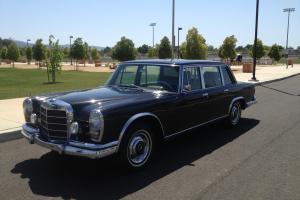 price: $73,957.001966 Mercedes-Benz 600 Pullman 6.3L SWB Chauffer Driven GLASS DIVIDER/BAR
price: $73,957.001966 Mercedes-Benz 600 Pullman 6.3L SWB Chauffer Driven GLASS DIVIDER/BAR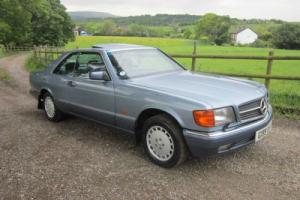 price: £3,995.001990 MERCEDES 500 SEC 126 SERIES COUPE(blue)
price: £3,995.001990 MERCEDES 500 SEC 126 SERIES COUPE(blue) price: $19,750.001984 Mercedes-Benz 300-Series
price: $19,750.001984 Mercedes-Benz 300-Series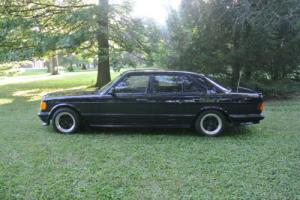 price: $US $5,800.001985 Mercedes-Benz 500-Series
price: $US $5,800.001985 Mercedes-Benz 500-Series
Latest arrivals:
-
$42,900.000
-
$7,100.000
-
$7,100.000
-
$7,099.000
-
$27,995.000
-
$42,499.000
-
$6,900.000
-
$23,900.000
-
$37,900.000
-
$135,000.000
-
$24,900.000
-
$185,000.000
-
$8,000.000
-
$149,000.000
-
$57,000.000
-
$24,999.000
-
$57,900.000
-
$7,900.000
-
$7,100.000
-
$27,000.000
